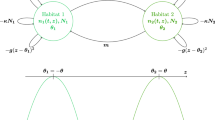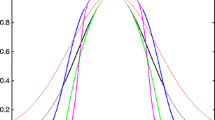Abstract
We present a general framework for modelling adaptive trait dynamics in which we integrate various concepts and techniques from modern ESS-theory. The concept of evolutionarily singular strategies is introduced as a generalization of the ESS-concept. We give a full classification of the singular strategies in terms of ESS-stability, convergence stability, the ability of the singular strategy to invade other populations if initially rare itself, and the possibility of protected dimorphisms occurring within the singular strategy's neighbourhood. Of particular interest is a type of singular strategy that is an evolutionary attractor from a great distance, but once in its neighbourhood a population becomes dimorphic and undergoes disruptive selection leading to evolutionary branching. Modelling the adaptive growth and branching of the evolutionary tree can thus be considered as a major application of the framework. A haploid version of Levene's ‘soft selection’ model is developed as a specific example to demonstrate evolutionary dynamics and branching in monomorphic and polymorphic populations.
Similar content being viewed by others
References
Abrams, P.A. and Matsuda, H. (1996) Fitness minimization and dynamic instability as a consequence of predator-prey coevolution. Evol. Ecol. 10, 167–186.
Abrams, P.A., Harada, Y. and Matsuda, H. (1993a) On the relationship between quantitative genetic and ESS models. Evolution 47, 982–985.
Abrams, P.A., Matsuda, H. and Harada, Y. (1993b) Evolutionary unstable fitness maxima and stable fitness minima of continuous traits. Evol. Ecol. 7, 465–487.
Balkau, B.J. and Feldman, M.W. (1973) Selection for migration modification. Genetics 74, 171–174.
Bishop, D.T. and Cannings, C. (1978) A generalised war of attrition. J. Theor. Biol. 70, 85–124.
Brown, J.S. (1996) Coevolution and community organization in three habitats. Oikos 75, 193–206.
Brown, J.S. and Pavlovic, N.B. (1992) Evolution in heterogeneous environments: Effects of migration on habitat specialization. Evol. Ecol. 6, 360–382.
Brown, J.S. and Vincent, T.L. (1987) Coevolution as an evolutionary game. Evolution 41, 66–79.
Brown, J.S. and Vincent, T.L. (1992) Organization of predator-prey communities as an evolutionary game. Evolution 46, 1269–1283.
Charlesworth, B. (1990) Optimization models, quantitative genetics, and mutation. Evolution 44, 520–538.
Christiansen, F.B. (1991) On conditions for evolutionary stability for a continuously varying character. Am. Nat. 138, 37–50.
Christiansen, F.B. and Loeschcke, V. (1980) Evolution and intraspecific exploitative competition. I. One-locus theory for small additive gene effects. Theor. Pop. Biol. 18, 297–313.
Christiansen, F.B. and Loeschcke, V. (1987) Evolution and intraspecific competition. III. One-locus theory for small additive gene effects and multidimensional resource qualities. Theor. Pop. Biol. 31, 33–46.
de Meeûs, T., Michalakis, Y., Renaud, F. and Olivieri, I. (1993) Polymorphism in heterogeneous environments, evolution of habitat selection and sympatric speciation: Soft and hard selection models. Evol. Ecol. 7, 175–198.
Dickinson, H. and Antonovics, J. (1973) Theoretical considerations of sympatric divergence. Am. Nat. 107, 256–274.
Dieckmann, U. and Law, R. (1996) The dynamical theory of coevolution: A derivation from stochastic ecological processes. J. Math. Biol. 34, 579–612.
Dieckmann, U., Marrow, P. and Law, R. (1995) Evolutionary cycling in predator-prey interactions: Population dynamics and the Red Queen. J. Theor. Biol. 176, 91–102.
Diehl, S.R. and Bush, G.L. (1989) The role of habitat preference in adaptation and speciation. In Speciation and Its Consequences (D. Otte and J.A. Endler, eds), pp. 345–365. Sinauer Associates, Sunderland, MA.
Eshel, I. (1983) Evolutionary and continuous stability. J. Theor. Biol. 103, 99–111.
Eshel, I. (1991) Game theory and population dynamics in complex genetical systems: The role of sex in short term and long term evolution. In Game Equilibrium Models I: Evolution and Game Dynamics (R. Selten, ed.), pp. 6–28. Springer, Berlin.
Eshel, I. (1996) On the changing concept of evolutionary population stability as a reflection of a changing point of view in the quantitative theory of evolution. J. Math. Biol. 34, 485–510.
Eshel, I. and Feldman, M. (1982) On evolutionary stability of the sex ratio. Theor. Pop. Biol. 21, 430–439.
Eshel, I. and Feldman, M. (1984) Initial increase of new mutants and some continuity properties of ESS in two-locus systems. Am. Nat. 124, 631–640.
Eshel, I. and Motro, U. (1981) Kin selection and strong evolutionary stability of mutual help. Theor. Pop. Biol. 19, 420–433.
Felsenstein, J. (1981) Skepticism towards Santa Rosalia, or why are there so few kinds of animals? Evolution 35, 124–138.
Ferriere, R. and Gatto, M. (1995). Lyapunov exponents and the mathematics of invasion in oscillatory or chaotic populations. Theor. Pop. Biol. 48, 126–171.
Gliddon, C. and Strobeck, C. (1975) Necessary and sufficient conditions for multiple-niche polymorphism in haploids. Am. Nat. 109, 233–235.
Hammerstein, P. (1996) Darwinian adaptation, population genetics and the streetcar theory of evolution. J. Math. Biol. 34, 511–532.
Hammerstein, P. and Selten, R. (1993) Evolutionary game theory. In Handbook of Game Theory with Economic Applications (R.J. Aumann and S. Hart, eds). North-Holland, Amsterdam.
Hofbauer, J. and Sigmund, K. (1990) Adaptive dynamics and evolutionary stability. Appl. Math. Lett. 3, 75–79.
Kisdi, É. and Meszéna, G. (1993) Density dependent life history evolution in fluctuating environments. In Adaptation in a Stochastic Environment (C.W. Clark and J. Yoshimura, eds). Lecture Notes in Biomathematics 98, 26–62.
Kisdi, é. and Meszéna, G. (1995) Life history with lottery competition in a stochastic environment: ESSs which do not prevail. Theor. Pop. Biol. 47, 191–211.
Levene, H. (1953) Genetic equilibrium when more than one niche is available. Am. Nat. 87, 331–333.
MacArthur, R. and Levins, R. (1964) Competition, habitat selection, and character displacement in a patchy environment. Proc. Nat. Acad. Sci. USA 51, 1207–1210.
Marrow, P., Law, R. and Cannings, C. (1992) The coevolution of predator-prey interactions: ESSs and Red Queen dynamics. Proc. Roy. Soc. Lond. B 250, 133–141.
Marrow, P., Dieckmann, U. and Law, R. (1996) Evolutionary dynamics of predator-prey systems: An ecological perspective. J. Math. Biol. 34, 556–578.
Matessi, C. and Di Pasquale, C. (1996) Long term evolution of multi-locus traits. J. Math. Biol. 34, 613–653.
Matsuda, H. and Abrams, P.A. (1994) Timid consumers: Self-extinction due to adaptive change in foraging and anti-predator effort. Theor. Pop. Biol. 45, 76–91.
Maynard Smith, J. (1966) Sympatric speciation. Am. Nat. 100, 637–650.
Maynard Smith, J. (1982) Evolution and the Theory of Games. Cambridge University Press, Cambridge.
Maynard Smith, J. and Price, G.R. (1973) The logic of animal conflict. Nature 246, 15–18.
Meszéna, G., Czibula, I. and Geritz, S.A.H. (in press) Adaptive dynamics in a 2-patch environment: A toy model for allopatric and parapatric speciation. Journal of Biological Systems.
Metz, J.A.J., Nisbet, R. and Geritz, S.A.H. (1992) How should we define ‘fitness’ for general ecological scenarios? Trends Ecol. Evol. 7, 198–202.
Metz, J.A.J., Geritz, S.A.H., Meszéna, G., Jacobs, F.J.A. and Van Heerwaarden, J.S. (1996) Adaptive dynamics: A geometrical study of the consequences of nearly faithful reproduction. In Stochastic and Spatial Structures of Dynamical Systems (S.J. van Strien and S.M. Verduyn Lunel, eds), pp. 183–231. North-Holland, Elsevier.
Motro, U. (1994) Evolutionary and continuous stability in asymmetric games with continuous strategy sets: The parental investment conflict as an example. Am. Nat. 144, 229–241.
Mylius, S.D. and Diekmann, O. (1995) On evolutionarily stable life histories, optimization and the need to be specific about density dependence. Oikos 74, 218–224.
Rand, D.A., Wilson, H.B. and McGlade, J.M. (1994) Dynamics and evolution: Evolutionarily stable attractors, invasion exponents and phenotype dynamics. Phil. Trans. Roy. Soc. Lond. B 343, 261–283.
Seger, J. (1985) Intraspecific resource competition as a cause of sympatric speciation. In Evolution: Essays in Honour of John Maynard Smith (P.J. Greenwood, P.H. Harvey and M. Slatkin, eds), pp. 43–53. Cambridge University Press, Cambridge.
Strobeck, C. (1979) Haploid selection with n alleles in m niches. Am. Nat. 113, 439–444.
Taper, M.L. and Case, T.J. (1992) Models of character displacement and the theoretical robustness of taxon cycles. Evolution 46, 317–333.
Taylor, P.D. (1989) Evolutionary stability in one-parameter models under weak selection. Theor. Pop. Biol. 36, 125–143.
Tilman, D. (1982) Resource Competition and Community Structure. Princeton University Press, Princeton, NJ.
Van Tienderen, P. and De Jong, G. (1986) Sex ratio under the haystack model: Polymorphism may occur. J. Theor. Biol. 122, 69–81.
Vincent, T.L. and Brown, J.S. (1989) The evolutionary response of systems to a changing environment. Appl. Math. Comput. 32, 185–206.
Weissing, F.J. (1996) Genetic versus phenotypic models of selection: Can genetics be neglected in a long-term perspective? J. Math. Biol. 34, 533–555.
Author information
Authors and Affiliations
Rights and permissions
About this article
Cite this article
Geritz, S., Kisdi, E., Mesze´NA, G. et al. Evolutionarily singular strategies and the adaptive growth and branching of the evolutionary tree. Evolutionary Ecology 12, 35–57 (1998). https://doi.org/10.1023/A:1006554906681
Published:
Issue Date:
DOI: https://doi.org/10.1023/A:1006554906681




